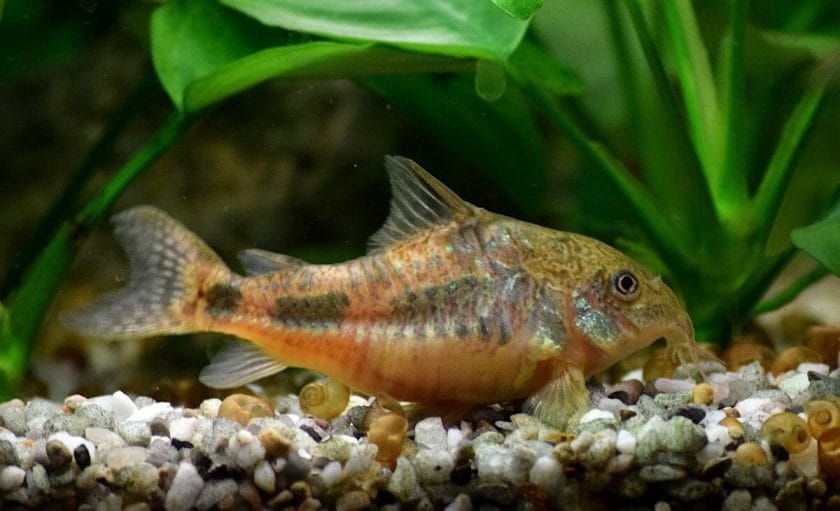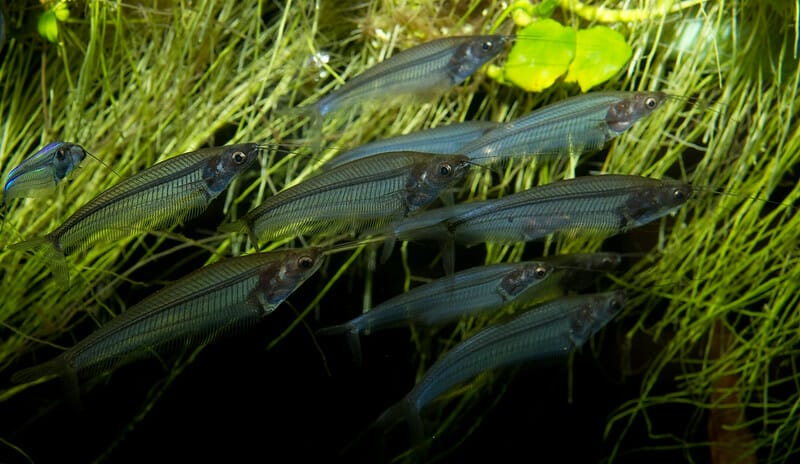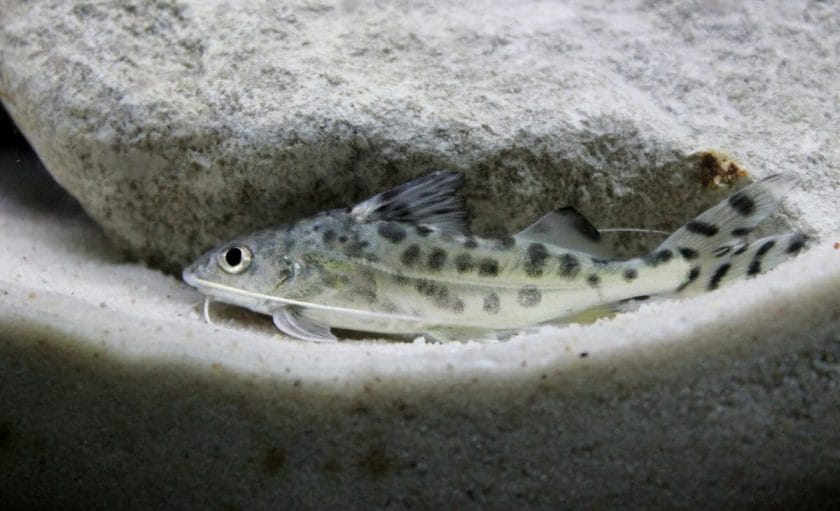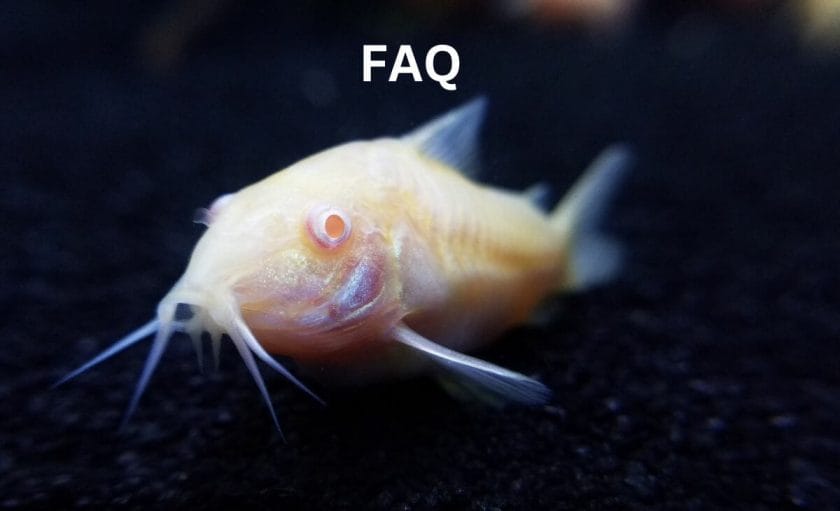Catfish are a popular species of fish for freshwater and saltwater aquariums, and thanks to their laid-back nature, these bottom feeders are great in many different settings.
Catfish species like Cories, Otocinclus, Asian Stone Catfish, Pictus Catfish, and Bristlenose Plecos are ideal for aquariums. Some species, like plecos, can also help contribute by keeping algae in check.
These species of catfish are not only easy to care for in many aquarium settings, but they can also help contribute to keeping the tank clean.
Read on, because I’m going to highlight some of the best species of catfish for beginners, as well as how they can benefit your tank.

Table of Contents
The Best Beginner Catfish For Freshwater Aquariums
Some species of catfish are better suited to a freshwater environment than others. These catfish generally have more easygoing temperaments and don’t require much active care.
Bristlenose Plecos

The bristlenose pleco is the most commonly recommended pleco, and for good reason. They are colorful, entertaining, and fit perfectly in most community tank environments. Plus, they can help clean your tank.
| Scientific Name | Ancistruc cirrhosus |
| Common Names | Bristlenose pleco |
| Adult Size | 5 inches |
| Temperature Range | 73 – 82 F |
| pH | 6.5 -7.5 |
| Minimum Tank Size | 20 gallons |
| Diet | Omnivorous |
| Colors | Black, brown, grey |
| Temperament | Peaceful |
| Water Hardness | 2 – 12 dGH |
| Care Level | Very easy |
Cory Catfish

Cory catfish are the most popular species of catfish for their small size, their non-aggressive nature, and the sheer number of species available. You can find cories in every shape and size, and most are very peaceful and easy to care for.
| Scientific Name | Corydoras paleatus |
| Common Names | Cory catfish, cory, corydora |
| Adult Size | 1 – 4 inches |
| Temperature Range | 70 – 82 F |
| pH | 6.0 – 8.0 |
| Minimum Tank Size | 10 gallons |
| Diet | Omnivorous |
| Colors | Black, white, brown |
| Temperament | Peaceful |
| Water Hardness | 5 – 10 dGH |
| Care Level | Very easy |
Striped Raphael Catfish

Image source under CC BY-SA 3.0
The striped raphael catfish is a standout in a tank environment, with gorgeous stripes. They tend to keep to themselves, but they can be territorial, so make sure your tank is the right size and that you have plenty of plants.
| Scientific Name | Platydoras armatulus |
| Common Names | Striped Raphael Catfish |
| Adult Size | 6 inches |
| Temperature Range | 75 – 86 F |
| pH | 6.5 – 7.5 |
| Minimum Tank Size | 30 gallons |
| Diet | Omnivorous |
| Colors | Black or dark brown with white stripes |
| Temperament | Semi-aggressive |
| Water Hardness | 4 – 30 dGH |
| Care Level | Medium |
Otocinclus

The otocinclus is an algae-eating machine and an adorable addition to any tank. They can be quite difficult to keep, if only because they are quite small. Be careful about which tankmates you include with your otocinclus, as other species may try to eat them.
| Scientific Name | Otocinclus spp. |
| Common Names | Otocinclus |
| Adult Size | 1 – 2 inches |
| Temperature Range | 72 – 78 F |
| pH | 6.0 – 7.5 |
| Minimum Tank Size | 10 gallons |
| Diet | Algae-based with lots of veggies |
| Colors | White with dark spots or brown line, species dependent. |
| Temperament | Generally peaceful |
| Water Hardness | 2 – 8 dGH |
| Care Level | Easy |
Bumblebee Catfish

Bumblebee catfish are very colorful and small catfish that add personality to a tank. Again, be mindful of their small size and make sure to target feed them as needed.
| Scientific Name | Microglanis iheringi |
| Common Names | Bumblebee Catfish |
| Adult Size | 2 inches |
| Temperature Range | 70 – 77 F |
| pH | 6.5 – 7.5 |
| Minimum Tank Size | 20 gallons |
| Diet | Omnivorous |
| Colors | Yellow and black stripes |
| Temperament | Generally peaceful |
| Water Hardness | 8-12 dGH |
| Care Level | Medium |
Glass Catfish

Glass catfish are unique among catfish in that they are middle swimmers. They also prefer to school, not just shoal like other species of catfish.
Glass catfish have a reputation for being challenging to keep due to the somewhat strict water parameters you will need to keep. Still, they are peaceful and make a great addition to a peaceful community tank.
| Scientific Name | Kryptopterus vitreoulus |
| Common Names | Glass Catfish |
| Adult Size | 4 – 6 inches |
| Temperature Range | 75 – 80 F |
| pH | About 6.5 |
| Minimum Tank Size | 30 gallons |
| Diet | Omnivorous |
| Colors | Grey, silver |
| Temperament | Peaceful |
| Water Hardness | 8-12 dGH |
| Care Level | Medium |
Pictus Catfish

The pictus is a great, distinctly colored catfish with a silver body and black spots. Just be mindful that they do grow up to 5 inches and that they have relatively strict temperature and pH requirements.
Still, if you’re up for the challenge, they’re a great addition to the right tank environment.
| Scientific Name | Pimelodus pictus |
| Common Names | Pictus Catfish |
| Adult Size | 5 inches |
| Temperature Range | 75 – 81 F |
| pH | 7.0 – 7.5 |
| Minimum Tank Size | 55 gallons |
| Diet | Omnivorous |
| Colors | Silver with black speckles |
| Temperament | Semi-aggressive |
| Water Hardness | 5-15 dH |
| Care Level | Medium |
What Makes Catfish Good for a Tank?

Determining how ideal a fish is for a tank consists of several factors. Generally, catfish that can thrive in a range of tank conditions, don’t have difficult care requirements, and are nonaggressive towards other fish are considered easy to care for.
Easy Care Requirements
When it comes to active tank monitoring, catfish species like plecos and cories don’t need much active maintenance. There are also many species of catfish, allowing you to choose one that fits right for your tank.
First, most catfish can thrive in slightly acidic or slightly alkaline water—anywhere from 6.0-8.0—although, just like many fish, they can be susceptible to sudden swings in pH.
The same is true of temperature, although some species like Otocinclus can be a little more sensitive when it comes to temperature range. In general, catfish prefer slightly acidic water at a cozy tropical temperature of 75-78 °F.
Diet is another care requirement for catfish that is very simple. Catfish will often eat detritus and leftover food and don’t require extensive care outside of regular target feeding. Most catfish incorporate algae into their diet, while some eat almost exclusively algae, such as the Wood Pleco.
In either case, this algae-centered diet means you only need to target feed your catfish a couple of times per week. Include a diet of blanched veggies, algae wafers, and bottom-feeder pellets.
Temperament
While some species of catfish can be semi-aggressive, many have a relaxed temperament and won’t pose a threat to a community tank.
Catfish like the Bristlenose pleco, Asian Stone Catfish, Otocinclus, and all species of Cory Catfish are nonaggressive and keep to their own. Others, like the Pictus Catfish, are still mostly shy but may be somewhat territorial.
It’s important to remember that catfish can be predatory by nature, and they will eat slow-moving, bottom-dwelling tank inhabitants that they can fit in their mouth. Still, in the context of an aquarium, incompatibility is rarely an issue.
They shouldn’t be paired with other aggressive bottom feeders, and the temperament is dependent on the species of catfish.
With plenty of hiding places via plants and hardscaping, catfish can sometimes be okay with semi-aggressive fish because they are out of the way on the bottom of the tank.
Here are some of the most commonly recognized peaceful catfish:
- Pygmy Cory
- Glass Catfish
- Bristlenose Pleco
- Otocinclus
- Bumblebee Catfish
Keep in mind that most catfish are territorial by nature. The factor that stops them from being a danger to other fish is that they dwell on the bottom, where they are unlikely to enter serious territorial disputes, as well as their smaller size (at least if we’re talking about aquarium catfish).
Contributions
Not only are catfish good for a tank in terms of care, they can also help keep the tank in good shape. Some species of fish, like catfish, help keep a tank clean by clearing out leftover food, which can build up ammonia.
Of course, feeding your tank the right amount is up to you. If there’s leftover food 30+ minutes after feeding time, you should scoop it out with a net and feed less next time. Still, catfish are great for clearing up leftover bits of food that work their way down to the bottom.
Some species of catfish will combat algae, some more than others. The Otocinclus, for example, is an algae-eating machine. Cories, on the other hand, prefer a mainly carnivorous diet.
Be mindful that catfish won’t eat every type of algae, and they are a supplement–not a solution–to keeping algae in check. Most algae-eating fish, for example, will not touch Black Beard Algae, as it is too hard.
Aside from the Siamese Algae Eater and Otocinclus, plecos are generally considered to be the best catfish for keeping your tank clean. Just be mindful that plecos can grow to a larger size and often need 30+ gallons to be happy.
FAQs

Do Catfish Eat Only Algae?
No, most catfish do not eat only algae. There are a few species of catfish that have a dominant diet of algae, but it’s still important to target-feed your catfish bottom feeder flakes and blanched veggies, as well as regular fish food that makes its way to the bottom.
Will a Catfish Eat Other Fish?
The general rule of thumb is that if a fish can fit another in its mouth, it will eat it given the chance. A slow-moving, bottom-dwelling fish/invertebrate is not a good pairing for catfish.
Do Catfish Have Barbels?
Aquarium catfish often have barbels, but they are not the stinging kind. Their function is to find food in the substrate.
Conclusion
Catfish are common in the pet fish trade for good reason; most species are hardy, easy to care for, and peaceful. They also come in a range of colors and sizes, making them a great addition to many tanks.
Be sure to refer to the helpful tables above to see which species I recommend for beginners, as well as which ones are the most peaceful!